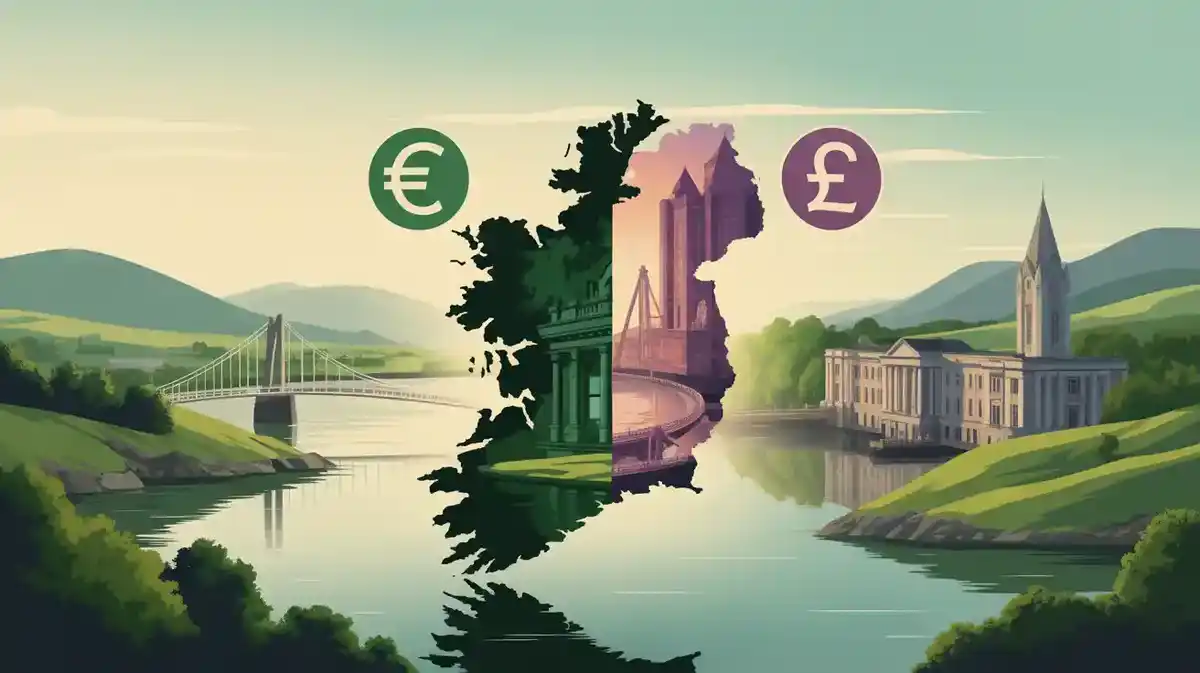Ultimate Ireland Currency Hack Guide: Save Fees & Stress in 2025
In 2025, the Republic of Ireland uses the euro (EUR, €) as its official currency, while Northern Ireland uses the British pound (GBP, £).
Traveling to Ireland in 2025 is simple when it comes to currency. If you’re in the Republic of Ireland, you’ll pay in euro (EUR, €). The euro is made up of cents, and you’ll use both banknotes and coins for purchases.
It’s the official currency used in shops, restaurants, hotels, and local markets. Most places accept cards, but it’s good to carry some cash, especially in small towns or markets.
- Republic of Ireland uses the Euro (EUR, €) – It’s the only legal tender accepted in cities like Dublin, Galway, and Cork.
- Northern Ireland uses the British Pound (GBP, £) – You’ll find banknotes from various UK banks, all valid in day-to-day use.
- Cards are widely accepted – Visa, Mastercard, Apple Pay, and Google Pay work in most places, but carry some cash for smaller towns or markets.
- Cash is still useful in 2025 – While digital payments are common, many rural areas, taxis, or local stalls may prefer or only take cash.
- Use trusted exchange options – Banks, airports, ATMs, and digital apps like Revolut, Wise, and N26 offer fair and convenient currency exchange.
- Avoid Dynamic Currency Conversion (DCC) – Always pay or withdraw in the local currency (EUR or GBP) to get the best exchange rate.
- ATMs are safe and accessible – Found across towns and cities, they support international cards and usually allow daily withdrawals of €600–€1,300.
- Best travel cards have no foreign fees – Cards like Wise, Revolut, and Charles Schwab (for U.S. travelers) are ideal for saving on transactions and ATM charges.
- A week in Ireland typically costs €735–€1,820 – Varies based on travel style: budget, mid-range, or luxury.
- Daily spending ranges from €80 to €239 – Budget covers hostels and pub food; higher budgets include hotels, tours, and fine dining.
- Sample prices help estimate costs – Coffee (€2–€4), pub meal (€10–€20), pint (€5–€7), taxi (€10–€15), and bus ride (€2.50–€4.50).
- Tours often include key expenses – Vagabond or Driftwood tours cover hotels, transport, and attractions; you’ll mainly pay for meals and extras.
- Carry around €100 in small notes – For tips, emergencies, or places where card isn’t accepted (especially in remote areas).
- Keep your money safe while traveling – Use belt wallets, neck pouches, and split your cash between different bags or secure spots.
- Avoid suspicious exchange services – Only exchange money at licensed banks, airports, or known exchange offices to avoid scams or fake notes.
- Use emergency cash options if needed – Bank apps and Irish post offices can provide temporary access to cash if your card fails.
- Notify your bank before you travel – This helps prevent blocks on your card and ensures smoother transactions abroad.
- Stick to paying in local currency – Whether withdrawing from ATMs or shopping, choosing EUR or GBP avoids poor rates and added fees.
- Ireland supports both digital and cash payments – With smart planning, you can travel comfortably and securely with the right payment mix.
Northern Ireland, part of the UK, continues to use the British pound (GBP). This setup reflects the long-standing connection and monetary system differences.
Previously, the Irish pound (punt, IEP) was used until 1979, when the Republic of Ireland joined the EU’s monetary system and later fully embraced the euro.
For tourists or those doing business with Irish organisations, the currency is easy to manage. Just look for the EUR symbol when buying or checking prices, and you’ll get better exchange rates after you arrive. Carry a bit of cash for emergencies, and enjoy the ease of payments across the country.
Republic vs. Northern Ireland Currency Explained
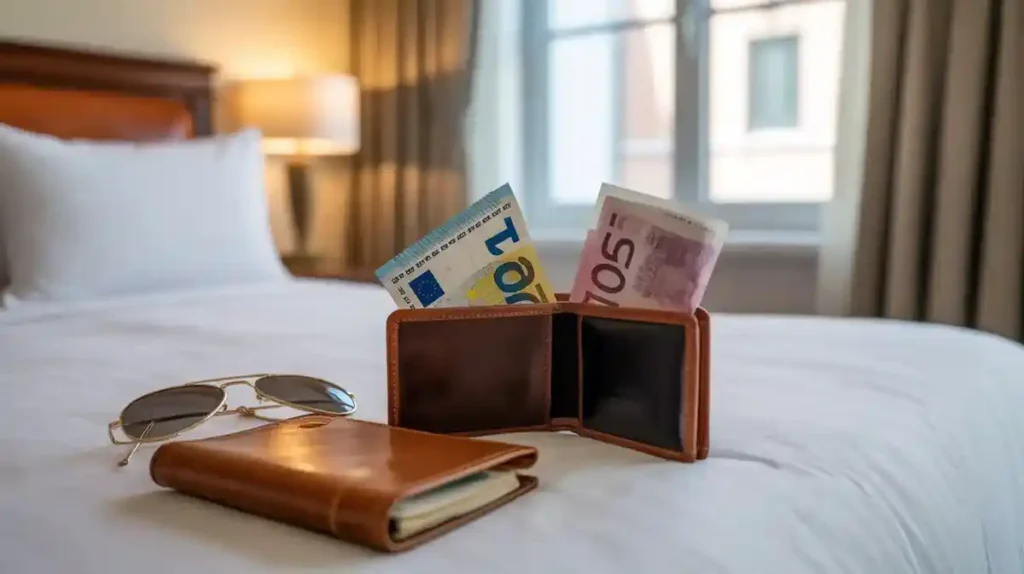
What Currency is Used in the Republic of Ireland?
In the Republic of Ireland, the official currency is the Euro (€). It was introduced in 2002 and is used throughout the country, including in cities like Galway, Cork, Limerick, and the capital, Dublin.
The Euro is the common currency for EU and Euro-zone members, and each Euro is divided into 100 cents. You’ll see the symbol € in shops, restaurants, and on receipts. The currency code EUR is used when exchanging currencies.
You can use the same Euro coins and notes in other European Union countries that accept the Euro. This makes travel between EU countries simple and convenient.
What Currency is Used in Northern Ireland?
Northern Ireland, part of the United Kingdom, uses the Pound Sterling (£). Unlike the Republic, pound notes from different banks circulate here, including the Bank of England, Ulster Bank, Bank of Ireland, and Northern Bank.
These individual currency notes are all accepted in general commerce and may look different even if they have the same value.
Visitors will also find notes from Scottish banks and occasionally the Bank of Isle of Man. This variety is normal and part of Northern Ireland’s banking system, supported by several major banks.
What Currency Does Dublin Use?
Dublin, the capital of the Republic of Ireland, uses the Euro (€). Like all other cities in the South, Dublin accepts Euro notes and coins.
Whether you’re shopping, dining, or paying for services, the Euro is the only currency used. Visa, Mastercard, Access, credit cards, debit cards, and contactless payments are widely accepted, offering convenience for all types of visitors.
What Currency Does Belfast Use?
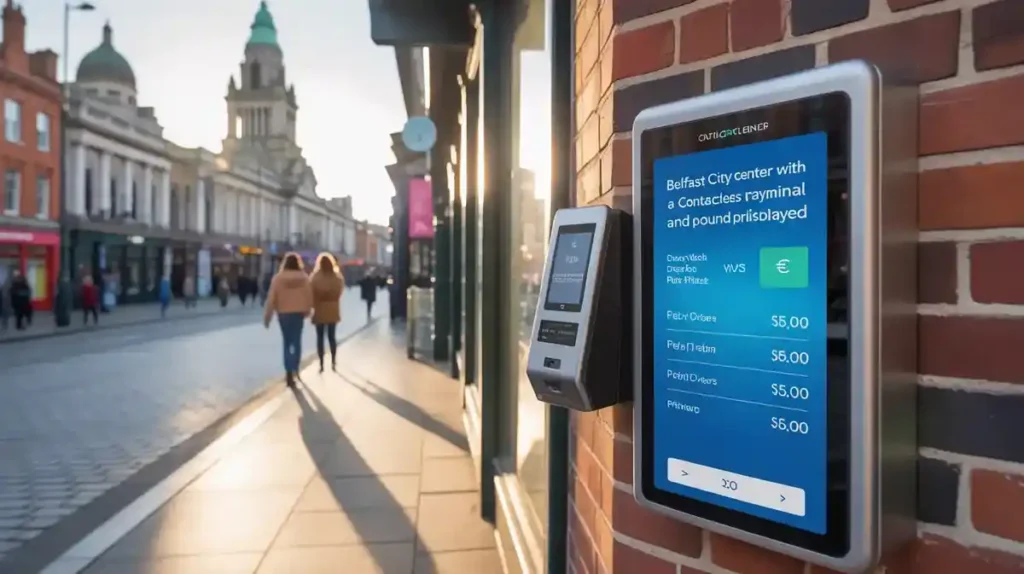
Belfast, located in Northern Ireland, uses the Pound Sterling (£). This is the same currency used across England, Scotland, and Wales. In Belfast, you’ll encounter different types of pound notes depending on which bank issued them. All are valid and used in everyday circulation.
Modern payment options are widely available. Visitors can use credit cards, debit cards, and contactless payments in most shops, restaurants, and service locations.
What Currency Did Ireland Use Before the Euro
The Irish pound was the official currency of Ireland before the euro. It was also called the punt, and it had the symbol £, often written as IR£ to show the distinction from the British pound sterling. The international code for this currency was IEP, and its ISO standard number was 4217.
The Irish pound was used for many years. It first began in the 10th century. In 1826, it merged with the British system. Later, Ireland formed its own version again after the establishment of the Irish pound in 1928.
This version lasted until 1 January 1999, when it was replaced by the euro. However, the euro didn’t start circulation right away. The beginning of physical euro coins and notes happened in 2002.
Ireland’s journey from the pound to the euro marked a big step in its financial history, connecting its economy more closely with the rest of Europe.
Can You Use Euros and Pounds Interchangeably in Ireland?
Traveling through Ireland gives you a chance to experience two different regions: the Republic and Northern Ireland. Each one uses its own currency, so having the right money is helpful.
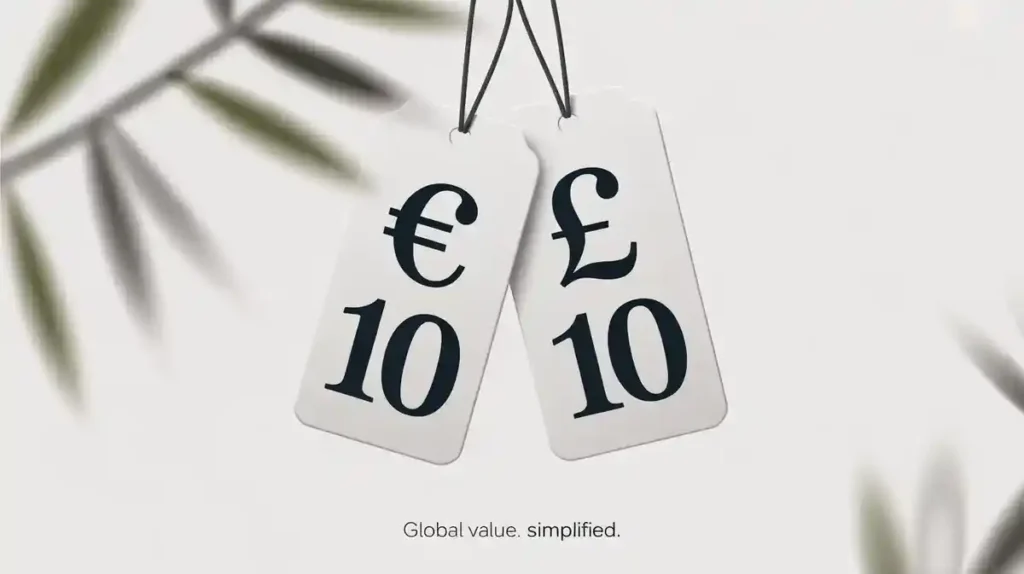
Many places accept cards, but it’s still smart to understand what kind of cash works where. Whether you’re going to Dublin, Galway, or Belfast, planning your payments makes the trip easier.
Can I Use Euros in Northern Ireland?
In Northern Ireland, the British pound is the official currency. While you’re near the border, some businesses may accept euros, especially in tourist areas, but it’s not guaranteed.
To avoid confusion or delays, it’s best to use pounds in this part of the country. Contactless and card payments are accepted in most locations, so you don’t always need to carry much cash.
Can I Use Pounds in the Republic of Ireland?
In the Republic of Ireland, the euro is the only legal tender. Shops and stores do not usually accept British pounds.
Even though the countries are close, their currency systems are different, and pounds are not used for everyday payments in the Republic. Visa, Mastercard, and debit cards work in most places, offering easy access to your money.
Does Ireland Accept US Dollars?
No part of Ireland—neither the Republic nor Northern Ireland—uses US Dollars for payment. Dollars are not legal tender in Europe. If you’re bringing cash from the US, you can exchange a small amount at certain locations for local currency.
However, for ease and better rates, using cards is often more practical. Banks and other entities in Ireland provide access to the correct currency if needed.
Let your travel be stress-free by planning ahead and knowing which currency to use where. This way, you can enjoy your time in Ireland without any payment worries.
Cash vs Card in Ireland (2025 Edition)
In Ireland, both cash and card payments are widely accepted in 2025. While the country is embracing digital payments, including contactless and mobile wallets, cash remains useful for small purchases, rural areas, and certain businesses. Most places in cities take cards, but it’s smart to carry some cash for flexibility.
Is Ireland Going Cashless?
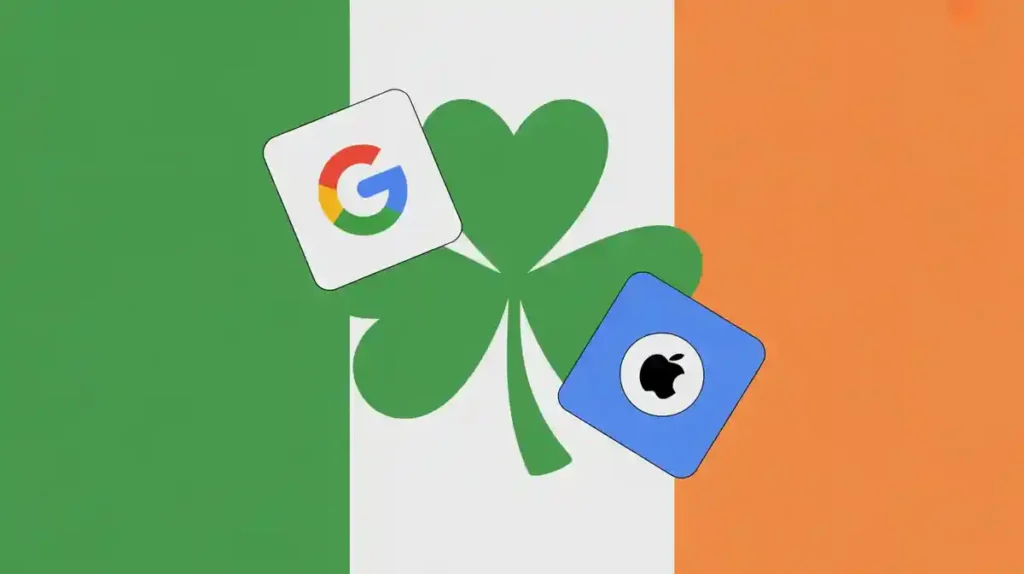
Ireland is moving toward a more digital payment lifestyle, but it is not a fully cashless society. Many people use debit cards, credit cards, and mobile payments, and businesses across the country accept these methods. However, the Central Bank of Ireland supports keeping physical cash available.
The Irish government also passed the Finance (Provision of Access to Cash Infrastructure) Act 2025, which protects people’s ability to use and access cash across the country.
The option to use cash is part of everyday life, especially for those who prefer it for budgeting or simple transactions. The Retail Banking Review 2022 confirmed strong public interest in keeping cash in the system.
Do I Need Cash in Dublin or Belfast?
In Dublin and Belfast, card payments are accepted almost everywhere — in hotels, restaurants, shops, and on public transport. You can comfortably use Visa, Mastercard, or your ATM card. In Northern Ireland, remember to carry British Pounds Sterling, while Euros are used in the Republic.
Still, it’s a good idea to carry some cash, such as €100 in small bills, for tipping, small markets, or unplanned situations. If you’re traveling to rural areas, having cash can make your trip smoother, as card machines may not always be available.
Contactless & Mobile Payments in Ireland (Apple Pay, Google Pay)
Contactless payments are the most popular way to pay in Ireland now. You can use a smartphone, smartwatch, or ATM card to tap and pay in most stores, cafes, and supermarkets. Apple Pay and Google Pay are accepted everywhere that offers NFC and contactless terminals.
Both apps are safe, using Face ID, Touch ID, PIN prompts, and strong encryption and tokenization. With these mobile wallets, you can also make payments online, within apps, or while traveling without needing a physical wallet. They’re fast, secure, and ideal for everyday spending.
When You Should Still Carry Cash (markets, taxis, rural towns)
There are still many places in Ireland where cash is better. At markets, craft stalls, or small shops, especially in rural towns, card payments might not be available. Some taxis and airport buses prefer or only accept cash, and honesty boxes for farm produce are also cash-only.
Sometimes businesses have minimum card transaction amounts, so having coins or small bills helps. When you’re outside major cities, especially in remote areas, it’s smart to carry cash as a backup.
Whether you use card, Apple Pay, or Google Pay, Ireland offers a modern, cash-friendly payment environment — with the freedom to choose what works best for you.
Currency Exchange in Ireland: What You Need to Know
Currency exchange in Ireland is simple and flexible. Travelers can exchange money at banks, ATMs, airports, and currency offices, or use digital apps like Revolut, Wise, and N26 for competitive rates. It’s easy to manage cash or cards, and knowing how to avoid Dynamic Currency Conversion (DCC) ensures better value.
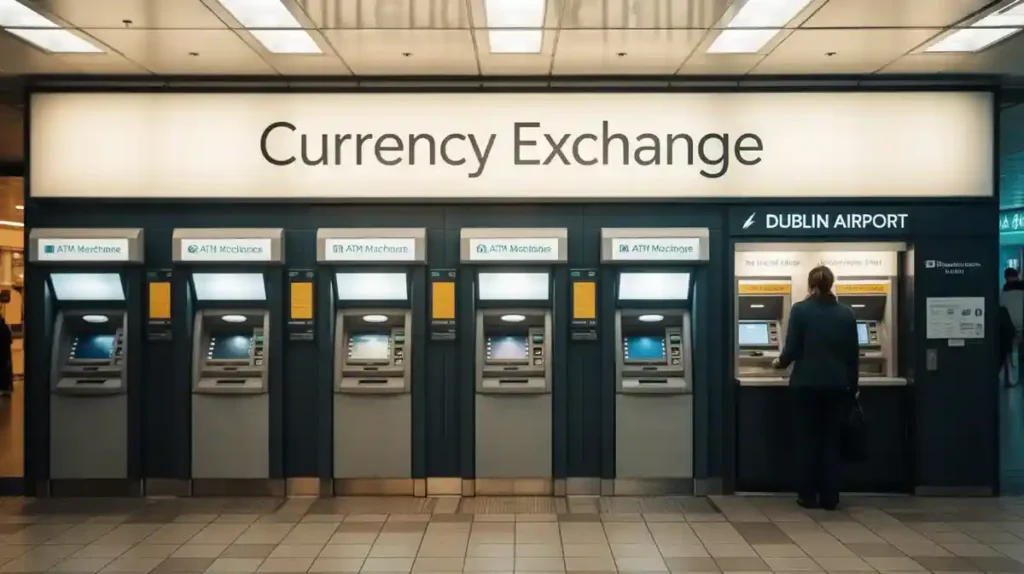
Where to Exchange Currency in Ireland (banks, ATMs, airports)
You can exchange currency at many places across Ireland. Banks such as AIB, Bank of Ireland, and PTSB (Permanent TSB) have branches in cities and towns, offering currency exchange services.
ATMs are available throughout the country and offer a convenient way to withdraw Euros directly. Services like ICE Currency Exchange provide ATMs at Dublin Airport and Shannon Airport. These ATMs often offer good access to cash, especially for travelers using Visa or Mastercard.
At the airport, you’ll find Bureau de Change desks from ICE Ireland Money Exchange, No1 Currency Exchange, and The Old Currency Exchange, located in both terminals of Dublin Airport and in Shannon Airport. For those who prefer in-person services, these are easy and reliable options.
Digital Currency Exchange Apps (Revolut, Wise, N26)
For tech-savvy travelers, digital apps like Revolut, Wise, and N26 offer excellent features. These apps support multi-currency accounts, making it easy to hold, manage, and exchange between currencies.
Revolut is popular for its competitive exchange rates, budgeting tools, and even cryptocurrency trading. Wise offers cost-effective international transfers with mid-market rates and transparent fees.
N26 combines a traditional banking experience with modern convenience and integrates with Wise for seamless international money transfers. All three are available across European countries, including Ireland, and support Google Pay and Apple Pay.
Typical Exchange Rates and Hidden Fees
Exchange rates vary depending on where and how you convert money. While airport kiosks are convenient, city center exchange shops, banks, and ATMs often provide better rates.
Apps like Revolut and Wise are known for offering near mid-market rates with clearly stated fees, helping users avoid surprises. Some services have subscription plans with added benefits, such as higher ATM withdrawal limits (e.g., €200/month free on Revolut). After that, a 2% fee may apply.
Avoiding Dynamic Currency Conversion (DCC) Traps

When using your card at stores, ATMs, or online, you might be offered Dynamic Currency Conversion (DCC) — a choice to pay in your home currency. It’s best to decline DCC and select local currency (euro) instead.
By choosing to pay in euro, your bank or card issuer will handle the conversion, usually with more favorable exchange rates and fewer fees. Using a travel card or a multi-currency account from Wise, Revolut, or Monzo also helps keep foreign transaction fees low. Having some cash on hand for small purchases or emergencies is also helpful.
Best Travel Cards for Ireland in 2025 (No Foreign Transaction Fees)
Best travel cards for Ireland in 2025 with no foreign transaction fees are Wise, Revolut, and the Charles Schwab checking account. These cards support multiple currencies, offer fee-free ATM withdrawals, and provide great exchange rates for international transactions.
Wise – Smart and Global
Wise is perfect if you’re traveling through Ireland, Europe, or beyond. It gives access to mid-market rates, a multicurrency account, and easy currency exchange.
You can top up in multiple currencies, pay in local currency, and track everything using their mobile app. It also supports Multicurrency IBAN, so receiving payments in different currencies is simple.
Revolut – Modern and Flexible
Revolut works just like a regular bank card, but with more power. It allows online banking, fee-free ATM withdrawals, and seamless exchange between currencies.
Great for both international travel and local spending, it also supports digital wallets, apps to check balances, and strong control over daily ATM limits.
Charles Schwab – Best for U.S. Travelers
For US residents, the Charles Schwab checking account is a top pick. It fully reimburses ATM withdrawal fees worldwide, making it ideal for extended trips.
The card works well in ATM networks like MoneyPass and Allpoint, and with no ATM fees, it’s especially useful if you’re hopping between countries.
Pro Tips for Using Travel Cards in Ireland
- Always notify your bank before traveling
- Use in-network ATMs to enjoy lower fees
- Stick to local currency (EUR) and avoid dynamic currency conversion (DCC)
- Consider a temporary increase to your ATM limit if needed
- Use apps and online platforms to locate ATMs and manage currencies
ATMs in Ireland: Everything Tourists Should Know
ATMs in Ireland are convenient, safe to use, and widely available across cities and towns. Tourists can access cash easily through well-known banks and international networks like Visa and Mastercard. Withdrawal limits vary, and emergency cash services are also accessible if needed.
Are ATMs Safe in Ireland?
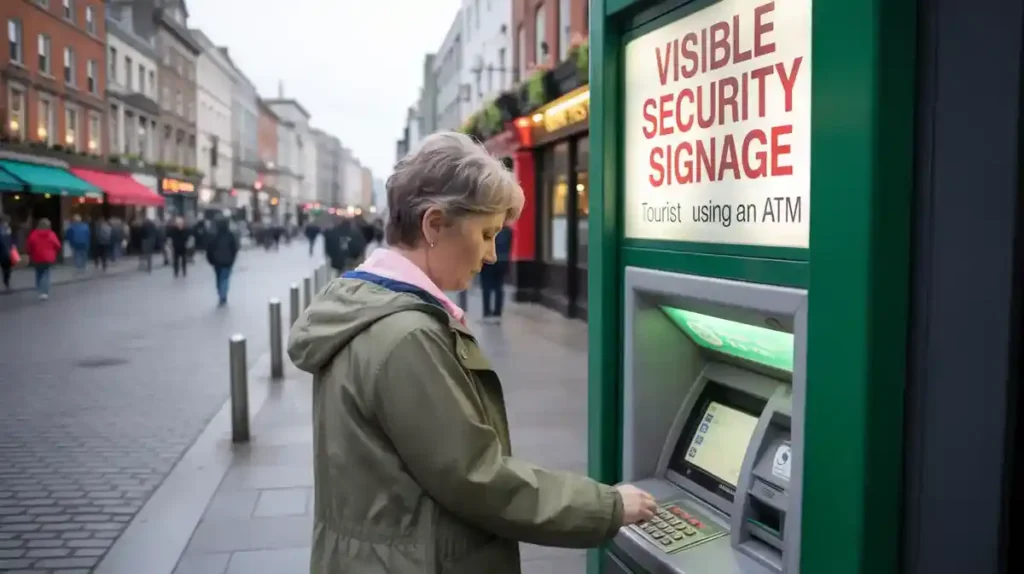
Yes, ATMs in Ireland are safe and found in well-lit, populated locations such as near banks and major businesses. For added peace of mind, tourists are encouraged to follow simple safety tips—like shielding your PIN with your hand or body, being aware of surroundings, and inspecting the machine for anything unusual before use.
Irish ATMs are maintained by trusted banks, and suspicious activity is rare but easy to report if noticed.
Common ATM Networks (AIB, BOI, Ulster Bank)
Ireland’s primary ATM networks are connected to major banks such as AIB (Allied Irish Banks), BOI (Bank of Ireland), and Ulster Bank. These ATMs are widely accepted and support international cards.
Most are compatible with Plus, Visa, Cirrus, and Mastercard networks. American Express and Maestro cards also work at many machines, while Discover may not be as widely supported.
How Much Can You Withdraw? (daily limits & fees)
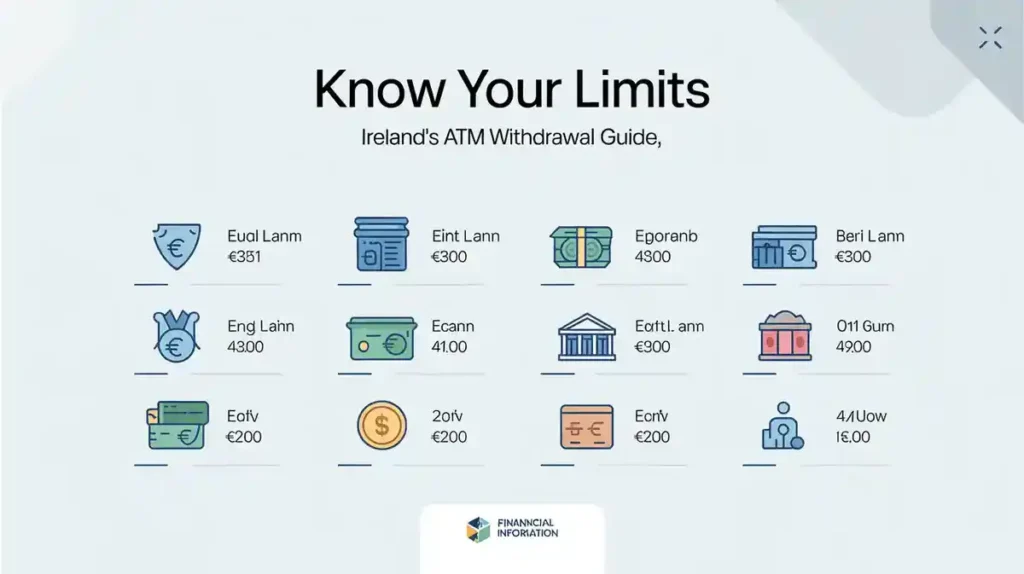
Tourists can withdraw cash up to €600–€700 per day from most ATMs. Some banks like Bank of Ireland allow higher limits, up to €1,300, with prior arrangements. AIB customers may access €1,500 using Cash & Cheque Lodgement Machines. If needed, you can contact your home bank for a temporary increase in limits.
While most local ATMs are fee-free when used with Irish cards, travelers may see fees depending on their account or plan. Revolut users may benefit from fee-free withdrawals based on tier.
Should You Withdraw in EUR or GBP?
In the Republic of Ireland, the official currency is the euro (EUR). However, if you’re also visiting Northern Ireland, you’ll need British Pounds (GBP).
Always withdraw in the local currency of the region you’re in—euro in the south and sterling in the north. This ensures better exchange rates and prevents extra charges.
Emergency Cash: What to Do if Your Card Doesn’t Work
If your card is lost, damaged, or temporarily blocked, you can access emergency cash—up to €200 per day—from any post office during opening hours.
Simply login to your banking app, use Quick Actions – Emergency Cash, or call Customer Services at 353 (1) 705 8000. This option is fast, secure, and helps travelers continue their trip without interruption.
How Much Do Things Cost in Ireland? (2025 Budget Guide)
In 2025, a one-week trip to Ireland typically ranges from €1,500 to €3,500 per person, depending on travel style and preferences. On average, daily costs fall between €80 for budget travel and €239 for a more comfortable experience, covering accommodation, meals, activities, and transportation.
Visiting Ireland in 2025 offers travelers options for every kind of budget. Whether you’re exploring charming villages or vibrant cities like Dublin and Galway, costs are flexible and value-packed.
A typical trip can be customized from budget stays to luxury experiences, and travel styles vary significantly to suit solo travelers, couples, or guided groups.
Daily Travel Costs in EUR and GBP
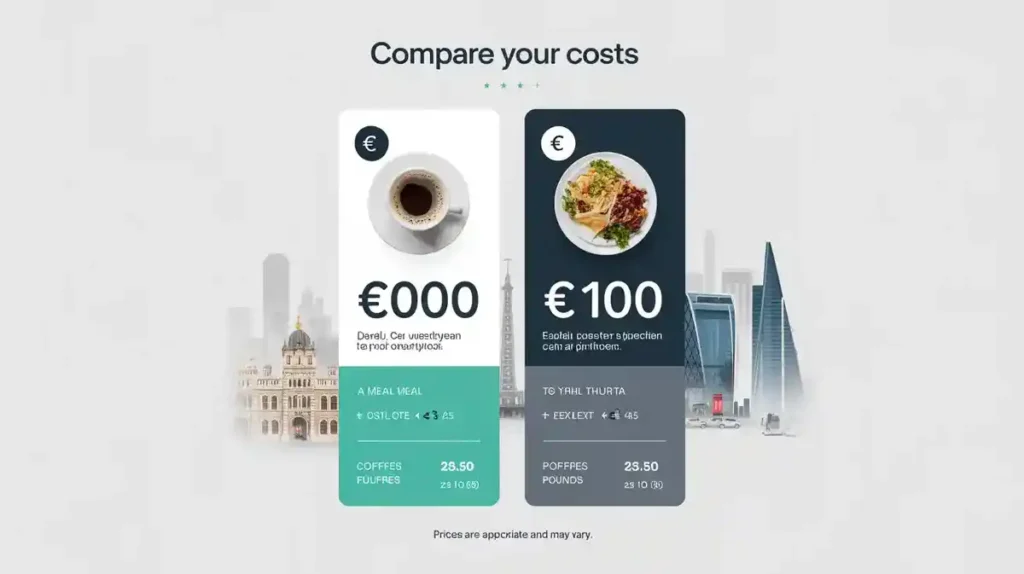
| Travel Style | Daily Budget (EUR) | Daily Budget (GBP) |
|---|---|---|
| Budget | €80 | £68 |
| Mid-range | €150 | £128 |
| Comfortable | €239 | £204 |
A budget traveler might spend around €80 daily, covering essentials like hostel dorms (from €15–€40), public transport (€2.50–€4.50 per trip with a LEAP card), and meals at local pubs (€10–€20).
Those choosing mid-range hotels (from €100–€200) and dining in restaurants (€25–€40) may spend more, with extras like guided tours or activities averaging €25/day through providers like Overland Ireland or Vagabond Tours.
Cost Comparison Table: Coffee, Meal, Taxi, Pint, Bus
| Item | Average Cost (EUR) | Average Cost (GBP) |
|---|---|---|
| Coffee | €2–€4 | £1.70–£3.40 |
| Pub Meal | €10–€20 | £8.50–£17 |
| Restaurant Meal | €25–€40 | £21–£34 |
| Pint of Beer | €5–€7 | £4.25–£6 |
| Taxi (City Ride) | €10–€15 | £8.50–£13 |
| Bus Ride | €2.50–€4.50 | £2.10–£3.80 |
Sample Currency Conversion from USD, GBP, CAD, AUD
| Currency | Approx. Exchange (2025) | €100 = X |
|---|---|---|
| USD | 1 EUR = 1.12 USD | $112 |
| GBP | 1 EUR = 0.85 GBP | £85 |
| CAD | 1 EUR = 1.50 CAD | $150 |
| AUD | 1 EUR = 1.65 AUD | $165 |
Ireland continues to be a rewarding destination for all kinds of travelers. With smart planning and flexible options like pre-planned tours, tailor-made stays in boutique guest houses, and help from local experts, your Irish adventure can be as exciting as it is memorable—without surprise expenses.
How Much Money Should I Take to Ireland for a Week
A one-week trip to Ireland typically costs between €735 and €1820, depending on your travel style. Budget travelers may spend around €105 per day, while mid-range travelers spend about €260 per day, covering food, transport, activities, and souvenirs.
Ireland offers a range of travel experiences to match different styles. Whether you’re backpacking on a budget or enjoying a more comfortable stay, planning your spending ahead makes your trip smooth and stress-free.
What’s Already Included on a Tour?
If you’re joining a Vagabond or Driftwood tour, you’re already saving. These tours include your hotels, breakfasts, guide, transport, and admission to major attractions. That means fewer daily costs and easier budgeting.
Daily Expenses Breakdown
Even with key expenses covered, you’ll want extra for meals and fun. Here’s a typical daily sample budget:
- Lunch + drink: €25
- Dinner + drink: €35
- Optional activities: €25
- Souvenirs and crafts: €30
This adds up to around €115 per day, giving you flexibility to enjoy Irish craftwork, local food, and cultural entertainment.
Travel Style and Budget Range
Your travel style greatly affects your total spend. According to The Currency Shop, here’s a detailed breakdown:
- Budget Travelers: ~€735 for 1 week
- Mid-Range Travelers: ~€1820 for 1 week
- Luxury Travelers: €4493 or more
Things to Consider
Think about your habits and choices. Staying in accommodation with a kitchen helps if you prefer self-catering or cooking. Using public transport instead of car rentals can cut transportation costs.
Always carry a mix of cash and card—some establishments in remote areas may prefer cash. Don’t forget to check your bank for currency exchange fees or international transaction charges before you go.
Having a little buffer for unplanned or surprise experiences makes the journey even better. With smart planning, you’ll enjoy every moment and make the most of your week in Ireland.
Currency Safety, Scams & Security Tips
To keep your money safe while traveling, use secure storage like belt wallets or hidden pouches, avoid showing large amounts of cash in public, and use trusted currency exchange services. Always carry backup cards, copies of important documents, and ensure your travel insurance covers unexpected issues like card loss or delays.
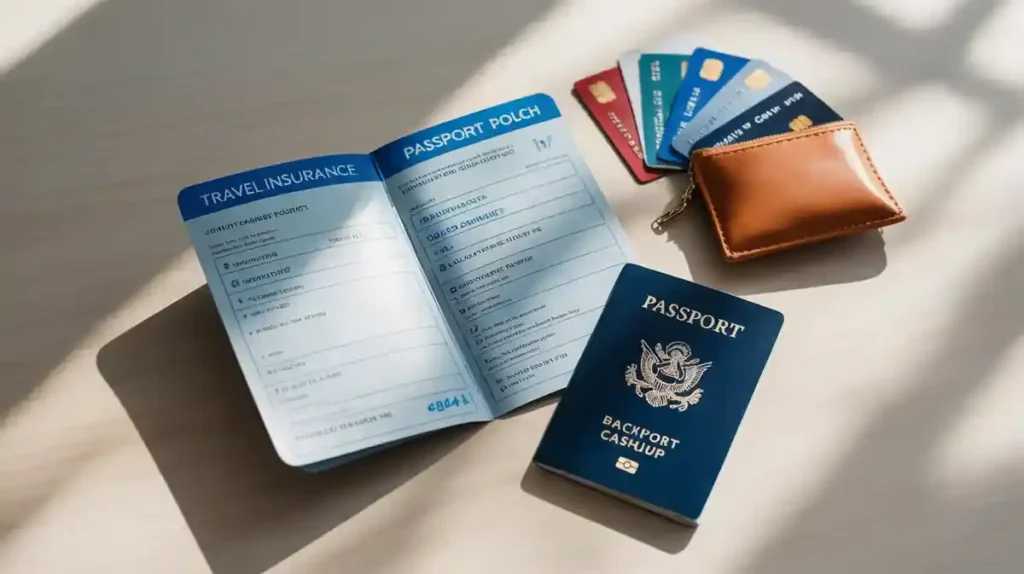
Avoiding Fake Notes & Bad Exchange Booths
When you exchange money, choose official financial institutions or reputable booths. Avoid street-side exchangers or anyone offering “too good to be true” rates. These can often give fake notes or short you on the actual value.
Look for booths that clearly display rates and follow customs and local laws. Use travel apps to check current exchange rates before accepting any offer.
How to Carry Money Safely (belt wallets, split storage)
Use belt wallets or neck pouches that can be worn under clothes. Keep small amounts of cash in a front pocket or decoy wallet with old cards. Use split storage: place money in different areas like a hotel safe, secure pouch, and traditional wallet.
Don’t keep all valuable items in one place. Move discreetly, especially in busy places. This keeps you protected from pickpockets.
What to Do if You Lose Your Money or Card
If you misplace your credit card or it gets lost, contact your bank or credit union using their hotline right away. They will cancel the card and send a replacement card. You can also visit the local Garda or police to report it.
Keep emergency contacts and digital copies of your passport, visa, and other travel documents saved in cloud storage or with you in physical copies.
Traveler Protection & Backup Plans
Always travel with good travel insurance. Choose one with comprehensive coverage for emergency expenses, trip cancellations, lost baggage, and even adventure activities like hiking or kayaking. Some plans also cover quarantine and medical emergencies.
Use a local SIM card to avoid roaming charges and stay connected. Be aware of cybersecurity when using public Wi-Fi. If your original accommodation or transportation falls through, have alternative accommodation and transportation alternatives planned.
With the right strategies, protection, and mindset, your trip can stay smooth, safe, and enjoyable while exploring new places and building positive relationships with locals.
Conclusion
In 2025, when visiting the Republic of Ireland, the Euro (EUR) is the official currency. For Northern Ireland, part of the UK, the Pound Sterling (GBP) is used. Knowing this helps make your travel simple and smooth. Both regions accept card payments in most shops, hotels, and restaurants, but it’s still wise to carry some cash for markets or small spots.
To get the most value, many travellers prefer to exchange their money once they arrive in the country, where rates are often better. ATMs offer good exchange options—just choose to pay in Euro or Pound, depending on the region. Always selecting the local currency avoids hidden costs and gives you a fair deal. Tools like Wise or CurrencyTransfer help with transferring, spending, and managing fees. These platforms offer helpful quotes, live rates, and trusted service from multiple payment providers.
With a travel debit card, your conversions, withdrawals, and spending stay sorted, letting you enjoy your visit to the Emerald Isle. Whether you’re a tourist or there for business, knowing the currency code, using a converter, and understanding your options ensures a smooth and cost-effective journey across Europe.
FAQs: Currency Use in Ireland (2025 Edition)
Should I get euros before going to Ireland?
It’s okay to wait until you arrive in Ireland to get euros. You’ll find ATMs at airports and banks that offer good exchange rates. You can also use travel money apps like Revolut or Wise for easy access to euros.
Is it better to use cash or card in Ireland?
You can use both cash and cards in Ireland. Cards are accepted almost everywhere, but cash is handy in small towns, markets, or taxis. It’s best to carry a mix of both.
What is the best currency to use in Ireland today?
In the Republic of Ireland, the euro (€) is the best and only currency to use. Northern Ireland uses the British pound (£), so use the right one based on where you are.
What currency should I take to Dublin?
Bring euros (€) when you visit Dublin. It’s the only currency used in the city. Shops, buses, and restaurants all accept euros and most take cards too.
Should I bring cash or card to Ireland?
Bring both cash and a card. Cards work in most places, but having cash is helpful in small shops or rural areas. A mix gives you the most options.
What is the most used currency in Ireland?
The euro (€) is the most used currency in the Republic of Ireland. It’s used in cities like Dublin, Cork, and Galway. People use it for shopping, travel, and dining.
How many euros should I bring to Ireland?
Bring around €100–€150 in cash for small expenses or emergencies. You can use cards for most things and withdraw more cash from ATMs if needed.
Can I pay in dollars in Ireland?
No, US dollars are not accepted in Ireland. Use euros in the Republic and pounds in Northern Ireland. If you bring dollars, exchange them at a bank or use an app.
Is 1500 euros enough in Ireland?
Yes, €1,500 is enough for a 1-week trip for most travelers. It covers hotels, food, local transport, and fun activities. Your budget may vary based on your travel style.
What is the best euro rate?
The best euro rates are usually found at local ATMs or by using travel money apps like Revolut or Wise. Avoid airport kiosks and always choose to pay in euros, not your home currency.
What is the best way to pay in Ireland?
The best way to pay in Ireland is with a contactless card or phone. Apple Pay and Google Pay work in most places. Still, keep some cash for backup.
What’s the best travel money card for Ireland?
Wise, Revolut, and Charles Schwab (for US travelers) are top travel cards. They offer good exchange rates, no foreign fees, and work with mobile payments like Apple Pay.
Disclaimer
This content is for general information only. For the latest currency rates or travel financial advice, consult your provider or financial expert. This article is published by TravelDrizzle.com, your guide to smarter global travel.
